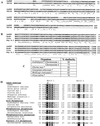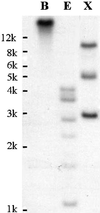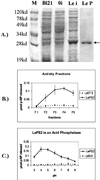LEPS2, a phosphorus starvation-induced novel acid phosphatase from tomato
- PMID: 11161030
- PMCID: PMC64874
- DOI: 10.1104/pp.125.2.728
LEPS2, a phosphorus starvation-induced novel acid phosphatase from tomato
Abstract
Phosphate (Pi) is one of the least available plant nutrients found in the soil. A significant amount of phosphate is bound in organic forms in the rhizosphere. Phosphatases produced by plants and microbes are presumed to convert organic phosphorus into available Pi, which is absorbed by plants. In this study we describe the isolation and characterization of a novel tomato (Lycopersicon esculentum) phosphate starvation-induced gene (LePS2) representing an acid phosphatase. LePS2 is a member of a small gene family in tomato. The cDNA is 942 bp long and contains an open reading frame encoding a 269-amino acid polypeptide. The amino acid sequence of LePS2 has a significant similarity with a phosphatase from chicken. Distinct regions of the peptide also share significant identity with the members of HAD and DDDD super families of phosphohydrolases. Many plant homologs of LePS2 are found in the databases. The LePS2 transcripts are induced rapidly in tomato plant and cell culture in the absence of Pi. However, the induction is repressible in the presence of Pi. Divided root studies indicate that internal Pi levels regulate the expression of LePS2. The enhanced expression of LePS2 is a specific response to Pi starvation, and it is not affected by starvation of other nutrients or abiotic stresses. The bacterially (Escherichia coli) expressed protein exhibits phosphatase activity against the synthetic substrate p-nitrophenyl phosphate. The pH optimum of the enzyme activity suggests that LePS2 is an acid phosphatase.
Figures







References
-
- Altschul SF, Gish W, Miller W, Myers EW, Lipman DJ. Basic local alignment search tool. J Mol Biol. 1990;215:403–410. - PubMed
-
- Aravind L, Galperin MY, Koonin EV. The catalytic domain of the P-type ATPase has the haloacid dehalogenase fold. Trends Biochem Sci. 1998;23:127–129. - PubMed
-
- Ascencio J. Acid phosphatase as a diagnostic tool. Commun Soil Sci Plant Anal. 1994;25:1553–1564.
-
- Barber SA. Soil-plant interactions in the phosphorus nutrition of plants. In: Khasawneh FE, Sample EC, Kamprath EJ, editors. Role of Phosphorus in Agriculture. Madison, WI: American Society of Agronomy; 1980. pp. 591–615.
Publication types
MeSH terms
Substances
LinkOut - more resources
Full Text Sources
Other Literature Sources
Research Materials
Miscellaneous

